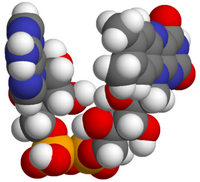
Photo from wikipedia
Here we summarize the most recent findings in the chemical-, photo-, or enzyme-triggered generation of nitrogen and oxygen anions leading to the formation of quinone methide intermediates (QMIs). This short… Click to show full abstract
Here we summarize the most recent findings in the chemical-, photo-, or enzyme-triggered generation of nitrogen and oxygen anions leading to the formation of quinone methide intermediates (QMIs). This short review is divided into two categories: generation of nitrogen and oxygen anions. Based on quinone methide intermediates (QMIs), proximate capture of a wide range of proteins has been widely determined and studied. Generally, the triggers include, photoirradiation using 365/254 nm UV light, small molecules (ROS/TBAF/s-tetrazine), metal catalysis (iridium catalysis), and enzymes (NQO1/β-galactosidase). New directions including far-red light, heat, force, microwave, and more practical approaches are explored and illustrated.1 Introduction2 Generation of the Nitrogen Anion3 Generation of the Oxygen Anion4 Conclusion
Journal Title: Synthesis
Year Published: 2022
Link to full text (if available)
Share on Social Media: Sign Up to like & get
recommendations!